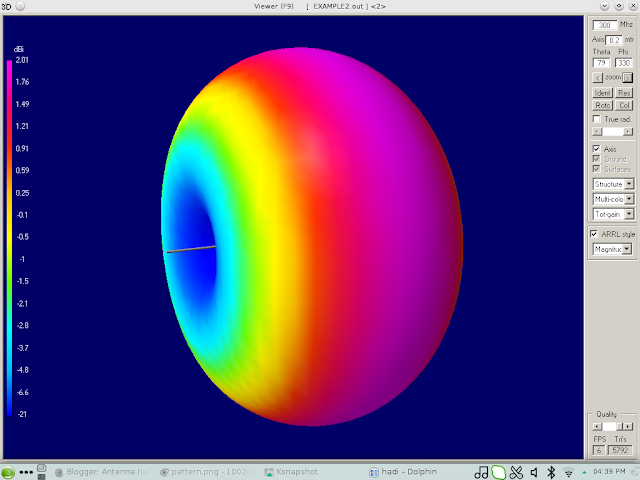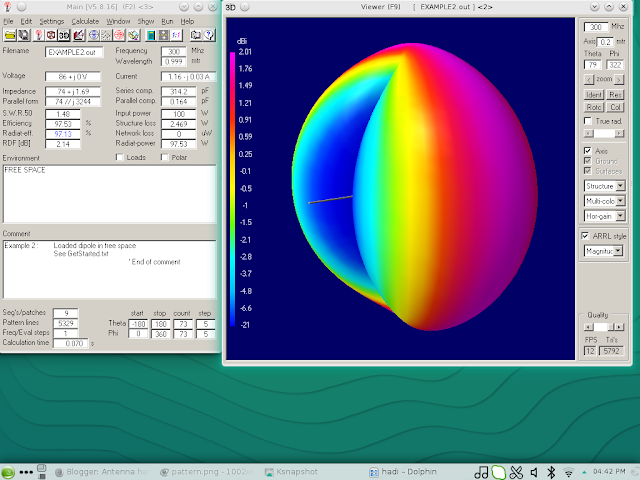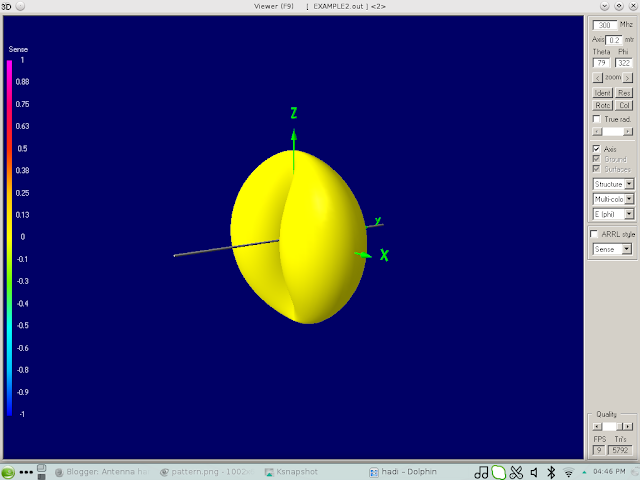470-800 MHZ is television reception band frequency , so we calculate Center frequency = 635 MHZ
Enter this centre frequency to the Geometry calculation 4nec2 software :
0.472 meter is lambda/2 for 635 MHz according to software .
0.009 is radius of wire in meter , equal to 9 mm pipe radius, made from copper
then calculate the formula by clicking F7 or go to calculate menu, then click NEC output data. The result is :
SWR still high 10.3 , we must re calculate for finding the best SWR, SWR wanted between 1.1 until 3 . And this is only sample for designing using 4NEC2 software for dipole antenna.
The Power output antenna also 3.94 dBi and the pattern antenna shows beside Main windows calculation.
This is 2D view of antenna with current propagation
This is 3D view of antenna pattern , with x,y,z cartesian with Power maximum at 3.87 dBi
3D view of antenna Zoom in
3D view of Vertical Gain calculation antenna
Current View of Antenna with Hide Pattern in Horizontal Propagation
3D Multicolor view of antenna with current propagation
3D Horizontal Gain with Current propagation in Horizontal view
2D Slices with horizontal current
Vertical gain antenna with current pattern
Vertical gain antenna with current propagation,
Antenna Handbook : Complete free tutorial antennas design , diy antenna , booster antenna, filter antenna , software antenna , free practical antenna book download !
Antenna Modeler and Optimizer using 4nec2 software
For antenna design model and optimize the design for analyse and calculate pattern and calculate Power of Receive and Transmit Power of antenna , I am using free and open source antenna modeler and optimizer 4nec2 from Arie Voors.
You can download in here http://www.qsl.net/4nec2/
You can download in here http://www.qsl.net/4nec2/
or Download from my GDrive
4nec2 support Windows operating systems and also Linux by installing Wine Software before installing 4nec2.
Feature from 4nec2 software : I get this from http://www.qsl.net/4nec2/ :
* Graphical 2D and 3D visualization of Far- and Near-field data and Geometry strutures (including circular polarization view).
* Line-chart visualization for freq-sweep Gain, F/B, F/R, SWR and impedance data. * Drag and drop style Geometry Editor to assist the starting antenne modeller.
* Full Nec2 and Nec4 command support, including GX, GM, GR, GA, GH and surface patches.
* Capable of running up to 11000 wires and/or segments (limited by the max of 2Gb of windows on-board memory)
* Support for inclusion of surface-wave component in far-field data. * 3D geometry display for surface patches included.
* Variable substitution included for complete Nec2/4 command set enabling you to model by equation. * Sophisticated real-time 3D geometry and pattern viewer showing real wire-radius.
* AO-style gradient/hill-climbing optimizer included.
* Genetic Algorithms based optimizer included.
* Automatic variable sweeper with line-chart output.
* Automatic convergence tester with line-chart output.
* Interactive Smith chart visualization for freq-sweeps.
* Integrated Sommerfeld ground calculations with frequency-sweep.
* Automatic generation of VOACAP propagation prediction type 13 and –14 antenna files.
* Automatic coversion of AO (*.ant)and EZnec (*.ez)input files.
* ‘Insulated-Wire’ and 'LC-trap' loading-types included.
* Automatic conversion for feet, inch, #awg to meters and elevation/azimuth to phi/theta and reverse.
* Batch processing for automatic testing, calculation and/or conversion of multiple Nec, AO and/or EZnec input-files.
* Extensive segment- en geometry validation, such as: Intersecting volumes, Short/thick wires at sharp angle, Unequal segmentation for parallel wires, Too low hight, Large radius or length changes at junctions, etc.
* Screen grabber for easy cut/paste, print or save parts of the screen, window or form. * Geometry builder to create cylindric, patch, plane, box, helix and parabola shaped structures using auto-segmentation and/or equal-area rules.
* Automatic generation of Stub-, L-, Pi- and Tee-matching-networks (low- and high-pass)
* Visualization of circular polarization components E(left) and E(right) for far-field. * EZnec style MiniNec ground included.
* Capable of running the default Lawrence Livermore National Laboratories Nec4 engine.
* Running on all systems from early Windows-95 to latest Windows-Vista * More than 450 example files
* Context sensitive Help-file.
* Completely free.
For tutorial 4nec2 you can get free on http://www.qsl.net/4nec2/Tutorial_4NEC2_english.pdf , I will also writing the tutorial for you with different example and different antenna design.
The example will talking about design 300 MHz antenna with SWR 1.48 , and wavelength 0.999 meter and input power antenna 100 Watt. See at the picture below from 4nec2 software :
On The example we can get information about frequency 300 MHz, wavelength 0.999 meter , SWR 50 1.48 , efficiency 97.53 % , antenna wire on xyz position and we can also can see smith chart calculation
Antenna Pattern also can be view from the software :
And also 2D and 3D antenna simulation signal from antenna , can be calculate and view by this software :
3D Zoom Mode
2D Mode View
Current Mode View
Vertical Gain View
Horizontal Gain View
Pattern Gain View
Phi Theta View Gain
3D Sense View
Tilt Phase View
Transparent View
Vertical Gain View
4nec2 support Windows operating systems and also Linux by installing Wine Software before installing 4nec2.
Feature from 4nec2 software : I get this from http://www.qsl.net/4nec2/ :
* Graphical 2D and 3D visualization of Far- and Near-field data and Geometry strutures (including circular polarization view).
* Line-chart visualization for freq-sweep Gain, F/B, F/R, SWR and impedance data. * Drag and drop style Geometry Editor to assist the starting antenne modeller.
* Full Nec2 and Nec4 command support, including GX, GM, GR, GA, GH and surface patches.
* Capable of running up to 11000 wires and/or segments (limited by the max of 2Gb of windows on-board memory)
* Support for inclusion of surface-wave component in far-field data. * 3D geometry display for surface patches included.
* Variable substitution included for complete Nec2/4 command set enabling you to model by equation. * Sophisticated real-time 3D geometry and pattern viewer showing real wire-radius.
* AO-style gradient/hill-climbing optimizer included.
* Genetic Algorithms based optimizer included.
* Automatic variable sweeper with line-chart output.
* Automatic convergence tester with line-chart output.
* Interactive Smith chart visualization for freq-sweeps.
* Integrated Sommerfeld ground calculations with frequency-sweep.
* Automatic generation of VOACAP propagation prediction type 13 and –14 antenna files.
* Automatic coversion of AO (*.ant)and EZnec (*.ez)input files.
* ‘Insulated-Wire’ and 'LC-trap' loading-types included.
* Automatic conversion for feet, inch, #awg to meters and elevation/azimuth to phi/theta and reverse.
* Batch processing for automatic testing, calculation and/or conversion of multiple Nec, AO and/or EZnec input-files.
* Extensive segment- en geometry validation, such as: Intersecting volumes, Short/thick wires at sharp angle, Unequal segmentation for parallel wires, Too low hight, Large radius or length changes at junctions, etc.
* Screen grabber for easy cut/paste, print or save parts of the screen, window or form. * Geometry builder to create cylindric, patch, plane, box, helix and parabola shaped structures using auto-segmentation and/or equal-area rules.
* Automatic generation of Stub-, L-, Pi- and Tee-matching-networks (low- and high-pass)
* Visualization of circular polarization components E(left) and E(right) for far-field. * EZnec style MiniNec ground included.
* Capable of running the default Lawrence Livermore National Laboratories Nec4 engine.
* Running on all systems from early Windows-95 to latest Windows-Vista * More than 450 example files
* Context sensitive Help-file.
* Completely free.
For tutorial 4nec2 you can get free on http://www.qsl.net/4nec2/Tutorial_4NEC2_english.pdf , I will also writing the tutorial for you with different example and different antenna design.
The example will talking about design 300 MHz antenna with SWR 1.48 , and wavelength 0.999 meter and input power antenna 100 Watt. See at the picture below from 4nec2 software :
On The example we can get information about frequency 300 MHz, wavelength 0.999 meter , SWR 50 1.48 , efficiency 97.53 % , antenna wire on xyz position and we can also can see smith chart calculation
Antenna Pattern also can be view from the software :
And also 2D and 3D antenna simulation signal from antenna , can be calculate and view by this software :
3D Zoom Mode
2D Mode View
Current Mode View
Vertical Gain View
Horizontal Gain View
Pattern Gain View
Phi Theta View Gain
3D Sense View
Tilt Phase View
Transparent View
Vertical Gain View
4G LTE 4 Pole Inter Digital Filter for Digital TV
This is the design of 4G LTE filter for Digital TV . As we know some of 4G LTE transmit frequency , overlapping with Digital TV reception frequency on 698 - 806 MHz. So, this 4 Pole Inter digital Filter made from aluminium plate and copper rod. You can experiment with it , I am not tested yet, for another design you can follow from VK3UM software online at VK3UM.com
LM 335 Temperature Sensor Circuit
Temperature Control
Circuit :
The temperature
controller circuit using +5 V voltage source from I/O slot at IBM
PC/XT/AT.
IC LM 335 from Texas
Instrument have the ability to detect temperature from ranging -40
celcius degree until 100 celcius degree.
This LM 335 from
Texas Instrument , is zener diode which have the linear coefficient
voltage increment related with increment of temperature with formula
:
Vz = + 10 mV/
C (celcius degree) , with
current opeartion between 400 uA until 5 mA.
On
the circuit Resistor 2.2 K use for limit the current flow to cathode
pin from LM 335 which is output of LM 335 sensor temperature.
On
circuit Resistance of R is 2.2 K , and at 25 Celcius degree from data
sheet of LM 335 , voltage at LM 335 will be 2.982 Volt , so current
flow can be calculate :
Vcc
= + 5 V
Voltage
at 25 Celcius on LM 335 = 2.982 V
Voltage
at Resistor R 2.2K is = 2.018 V
Current
flow through LM 335 and R will be = 2.018 V / 2.2 K = 0.9 mA
This
0.9 mA current at LM 335 still on at range of sensor LM 335, and then
the output cathode pin of LM 335 sensor from Texas Instrument connect
to input 0 of ADC0809 Analog and Digital convertion data from Texas
Instrument at pin 26.
Temperature Sensor LM 335 from Texas Instrument
Temperature Sensor
using IC LM 335 from Texas Instrument. LM 335 is Zener Diode which
sensitive of temperature change in it surrounding , which is reverse
bias on it breakdown area with output :
Vz = [10 mV/Kelvin]
…..........[2-1]
Because there is gap
different 273 degree between Kelvin and Celcius , so the output in
Celcius for LM 335 from Texas Instrument will be :
Vz = 2.73 Volt + [
10 mV/Celcius] T.........[2-2]
where T is in
Celcius Degree
IC LM 335 from Texas
Instrument have temperature range between -40 celcius degree – 100
celcius degree
I use LM 335 in
Plastic Package TO-92 , another package for LM 335 is SOIC
Images courtesy Texas Instrument
Another IC
temperature sensors from Texas Instrument are LM135, LM135A with
TO-46 package, LM235 and LM235A in TO-92 package and LM 335 and LM
335A in SOIC package.
From this writing, I want to discuss about Simulation control system with IBM PC
XT/AT for Temperature, heater, and pump using LM 335 as sensor, PIO 8255, ADC 0809 , MOC from motorolla , and TRIAC .
This control system operate with software with QBasic , and I will write the schematic diagram, implementation, and software design.
For more data about LM335/LM335A . please visit data from Texas Instrument , here
4G LTE Bandstop Antenna UHF Filter 703 MHz - 803 MHz
As from 4G LTE Band spectrum, we can see that at LTE Band 44 , allocation frequency of 4G LTE at 703 MHz-803 MHz. And this spectrum frequency , overlapping with digital TV spectrum. As we know, digital tv spectrum frequency at band 703 MHz - 803 MHz, with bandwith 100 MHz.
So the center frequency will be :
Center Frequency 703 - 803 MHz = 753 MHz
I use Bandstop filter calculator refer to http://www.wa4dsy.net/filter/filterdesign.html
After we input the parameter of center frequency 753 MHz , and bandwith 100 MHz at calculator, then click compute parts as the menu on calculator, then we get the result of 3 filter design with 2 circuit , butterworth, bessel, and chebyshev.
The component values of 3 design filter, for butterworth, bessel, and chebyshev are :
You can choose one of three offering design and choose one of two circuit for your implementation.
The output chart graph of filter design are :

So the center frequency will be :
Center Frequency 703 - 803 MHz = 753 MHz
I use Bandstop filter calculator refer to http://www.wa4dsy.net/filter/filterdesign.html
After we input the parameter of center frequency 753 MHz , and bandwith 100 MHz at calculator, then click compute parts as the menu on calculator, then we get the result of 3 filter design with 2 circuit , butterworth, bessel, and chebyshev.
You can choose one of three offering design and choose one of two circuit for your implementation.
The output chart graph of filter design are :

3 Pole Bandpass Filter for uhf digital tv 470-800 MHz
This 3 pole bandpass filter using https://wetnet.net/rf_design/3pole.main.cgi design calculator online.
this bandpass filter is butterworth filter and intended to filter digital tv bandwith 470MHz to 800 MHz , and only this signal will detected after antenna.
Parameter of filter :
Band Frequency 470 - 800 MHz
Center Frequency = 635 MHz
Bandwith = 400 MHz
Impedance = 50 ohm
Input this parameter to online filter calculator above :
Click Submit , and the result :
L1,L3 : 0.008763 uH ( 8,763 nH)
L2 : 0.039789 uH (39.789nH)
C1,C3 : 0,000008 uF ( 8 pF)
C2 : 0,000001753 uF (1,753 pF)
We must determine for Inductor L1,L2,L3 the coil diameter, coil length and number of turn of coil.
Using online calculator from http://www.qsl.net/in3otd/indcalc.html we can determine diameter, length and number of turn coil.
For L1,L3 :
L = 0,00876 uH , coil diameter will be d : 0,01 m , Coil length will be l : 0.01 m and number of turns , n : 1,1355
And for L2 :
L = 0,0396 uH , coil diameter will be d : 0,0259 m , coil length will be l : 0,01 m and number of turns n : 1,1355
The most important thing of build filter is the connection between component should be as close as possible, for avoiding wild capacitance that will generate noise, and the ground area of PCB should be good and wide.
On the next article, I will posting the implementation of this filter.
LSI Chip intel Programmable Peripheral Interface (PPI) 8255
Intel Chip PPI 8255
Image courtesy of wikipedia.org Chip LSI internal configuration PPI 8255 shows the figure 1. In figure 1, pin IC 8255 consists of 3 groups: 1. Read / Write Control Logic 2. Data Bus Buffer 3. Input / Output Ports Image courtesy of wikipedia.org READ / WRITE CONTROL LOGIC Groups Read / Write Control Logic organize all data and controls, both internal transfers Form and Form of Transfer externally. ACCEPT singer group input from address bus and bus control CPU, the group later realize Ke - Control group. Pin - pin Of The Read / Write Control Logic is as follows: CS (Chip Select) Low ON signal pin singer will be to enable communication LSI Chip PPI BETWEEN 8255 TO microcomputers. RD (Read): Low ON signal pin singer will be to enable the CPU to review read status information OR Data From Chip LSI PPI 8255 WR (Write) Low ON signal pin singer will be to enable the CPU to write a review OR Data Into PPI control word 8255 A0 and A1: The input selector is functioning as part of the Joint Control word - the same WITH RD and WR. Basic Operations The Group is controlled by the Read / Write Control Logic singer portrayed ON the table below. re: ON logic high reset input will be to clear the contents of the list of controls and harbor ALL To set the input mode. Control Group A and Group B: Configuration functions From EVERY port in the software program by. IN AN basically CPU provides output control word addressed to the LSI Chip Control Word 8255. PPI mode provides information about, bit set, bit reset, And Others. Singer configuration is used to initialize the configuration functions review Chip LSI 8255 PPI. EVERY Control blocks (Group A and Group B) RECEIVE command From the Read / Write Control Logic, And said menerimacontrol Data From internal bus (internal data bus) and execute commands - Commands Right to review arrangements port - port ITU. ON said control registers can only perform write operations, NO can perform read operations. DATA BUS BUFFER The data bus is a 3 state buffer 8 bit With operations Operating prayer Arah (both directions), ayng used to review 8255 WITH connect Chip PPI data bus system. Data Sent and received through the data buffer bus, Similarly to review the control word. PORT INPUT / Output Port Input / Output Was Part Of The 8255 PPI chip serves as a liaison
Subscribe to:
Comments (Atom)








































